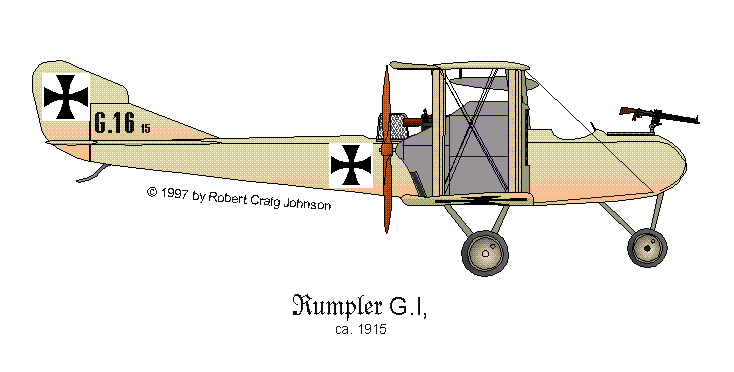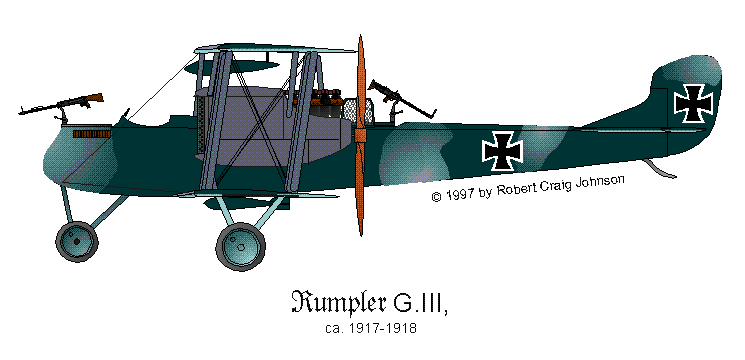
The rugged Rumplers are not generally remembered as the important early German 'Battleplanes' that they were. None ever fell into the hands of the Allies to be assessed and recorded as part of the Central Power's flying equipment. As the entry for the Rumpler G type in Jane's Encylopedia of Aviation notes, "It is a curious fact that no example of the Rumpler G type twin engined bomber was captured or traced during World War I, in spite of its engagement on active service on all fronts."
Rumpler was already a well-established aircraft company at the beginning of the World War. Though best known later for the excellent, single-engined, high altitude reconnaissance aircraft of 1917-18, the firm built its early success on the manufacture and licensing of Etrich's graceful taube and B.I military aircraft. The Rumpler Werke was thus in a good position to respond to the specification issued by Idflieg in June of 1914 for a Type III Kampfflugzeug ("combat aircraft"). This was to have 200 hp and was to be capable of carrying a crew of three for six hours. As aero motors of the time were of modest performance, the horsepower stipulation necessitated a twin-engined design. The first prototype (4A 15), with 150 hp Benz Bz III engines, was ready for military competition the following spring. It gave sufficient performance for a small number to be ordered. This machine possessed exceptional climb and lift capabilities for its time, carrying ten personnel to an altitude of 10,000 feet and sixteen to nearly 6000 feet.

After the flying surfaces had been redesigned, the G I (5A 15) went into limited production. A total of 58 were eventually produced. It was of conventional wood and fabric construction. The two, fully-cowled Bz III or 160-hp Mercedes engines drove pusher airscrews between unstaggered wings, following the popular configuration for German heavy bombers of the period. Armament consisted of a single 7.92-mm Parabellum machine-gun in the nose and a modest bomb load.
The G II (5A 16) was fitted with partially enclosed, 220 hp Benz Bz IV engines. While the G I was developed largely before the advent of fighter aircraft (the single forward machine gun was ostensibly offensive armament), the G II was introduced in mid-1916, by which time a rearward firing weapon was necessary to fend off the growing threat of armed single-seat, single-engined "scouts" [fighters]. In other respects, the G II was essentially similar to the G I.
The final development of the Rumpler twin was the G III (6G 2). It had more powerful 260-hp Mercedes DIVa engines. Aerodynamic refinements included reduced tail surfaces, negative (backwards) stagger on the wings and horn-balanced ailerons that enhanced lateral control.
The collective operational careers of the Rumpler G-types spanned more than three-quarters of the war, from mid-1915 through the summer of 1918. While the competing AEG and Gotha G types were still in the developmental stages, Rumpler G-Is were quietly serving in small numbers in the first German bomber squadrons. Some G-IIs probably served with Bombgeschwader 1 in Macedonia alongside another little-known tactical bomber, the Albatros G-III. By October of 1917, twenty Rumpler G.IIIs were at the front engaged in night bombing and continued in this role until withdrawn in August of the following year.
Text © 1997 by Riordan Goodwin. Published by permission of the author. Art © 1997 by Robert Craig Johnson.